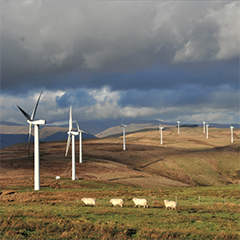The state of flux in the UK’s onshore wind sector has never been more apparent than at present. On the one hand, wind energy and other renewable energy sources are currently generating over a quarter of power consumption across the UK annually, at a price cheaper than gas and nuclear, all while enjoying the highest level of public support.
At the same time, however, national policy and regulatory backing is at a particularly low ebb, and investor confidence has been dented to such a degree that the pipeline for new development has largely stalled.
Recent years have seen the cessation of both the Renewables Obligation (RO) scheme and Contract for Difference (CfD) support for onshore renewables, coupled with the rapid degression of Feed-in-Tariff (FiT) payments for all renewables prior to its phase-out in March 2019.
These support mechanisms enabled a staggering build-out of onshore wind capacity equal to nearly 5GW since 2012, with some 2.6GW of new generation installed in 2017 alone. In combination, onshore and offshore wind contributed approximately 45% of the UK’s total renewables capacity, resulting in some 37,400 megawatt hours of annual generation.
This is roughly equivalent to the domestic power consumption of 12 million homes, offsetting in the range of 20 million tonnes of CO2 that would otherwise have been produced through conventional power generation.
On the face of it, then, the UK’s onshore wind industry should be in a strong position. It has already fulfilled much of its promise, despite the protests of many who never believed the wind sector would be a worthwhile partner in the UK’s energy mix, and there is still plenty of remaining wind capacity to be harnessed if there is sustained support politically and publicly.
However, as the current construction boom draws to an end, there are fears that installed wind capacity is at a precipitous cliff-edge. Over the past three years, and ahead of the nose-dive in subsidy support, the decline has been most apparent in the small and medium wind sector, where development has clearly faltered.
Enquiries regarding new developments at this scale have rapidly diminished, wind generators are no longer seen as viable opportunities for the economic diversification of landholdings, and it is evident that there are just a handful of remaining existing sites with previously secured planning permission that remain viable.
These sites have the opportunity to take advantage of second-hand, reconditioned machines from Europe that are cheaper than the price of new turbines. Yet the rate of new installs at this scale has been dramatically reduced, most noticeably in England where there is, in effect, a de facto moratorium on new wind installation. In addition, a lack of government support for onshore wind has been further compounded by the recent decision to delay any discussion of renewed subsidy support.



























